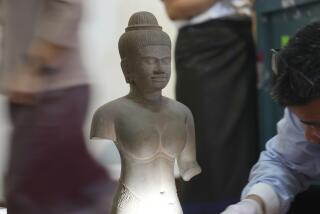Exhibit in Berkeley Offers Window on Tibet’s Lost Libraries : Culture: Monks braved gunfire and starvation to smuggle out manuscripts when China invaded. ‘They had a choice between carrying books and food,’ publisher says.
- Share via
BERKELEY — Lined up in row after row of gold-stamped order, their elegant bindings bathed in a soft amber glow, the vast collection of books projects an aura of serene scholarship.
But behind the newly published volumes lies a tale of tragedy and loss, of sacred manuscripts smuggled to freedom and rescued from the detritus of a pillaged culture.
This book-lined room is the result of a 25-year mission to recreate the lost libraries of Tibet.
“The basic structure of Tibetan knowledge is here,” says Sylvia Gretchen of Dharma Publishing, which is showcasing its efforts with a new exhibit, “Sacred Art and Books of Tibet.”
The numbers behind the display, which runs through Feb. 25, are daunting.
There are 755 atlas-sized volumes encompassing 35,973 texts written by 1,542 authors. The collection includes the General Tibetan Buddhist Canon, known as the Kanjur and Tanjur, and the Nyingma Canon, Great Treasures of Ancient Teachings.
The exhibit also includes art reproductions of more than 400 images, believed to be larger than any one museum or Tibetan collection anywhere.
The collection serves two purposes--to send books back to the Tibetans (60,000 volumes so far, more planned) and to make the body of knowledge available for research libraries.
For display purposes, the books, which are hand-bound works of art and also in Tibetan, stay on the shelves. The exhibit also includes video presentations, photographs, printed timelines and docent tours to introduce the history of Buddhism.
Stories behind the manuscripts that went into the books are dramatic. Some were smuggled out by monks fleeing across the bleak slopes of the Himalayas, braving gunfire and starvation.
“They had a choice between carrying books and food,” says Gretchen. “Some of them carried only books and they died, unfortunately. Some of them carried only books and they survived.”
Other pieces were found in museums and libraries as well as more unexpected places, such as the 16th-Century sacred painting found rolled up and tucked beside a stash of logs next to the owner’s fireplace.
Dharma Publishing traces its roots back to 1962, when exiled Tibetan lama Tarthang Tulku founded a small press in India to begin publishing texts brought out of Tibet after the Chinese invaded.
The company, which moved to the United States in 1970, is nonprofit and staffed by volunteers, with Tulku serving as director. Publishing and donation efforts are funded by sales of other books, including a number of English-language books about Buddhism.
Dharma Publishing also prints long strips of paper covered with mantras (prayers) coiled inside copper prayer wheels. The wheels, which look a bit like a copper drum mounted on a short wooden stick, can be spun around. The motion is believed to activate the energy of the prayers inside.
Like a portable CD player, the drum can be opened and a new coil of mantras inserted.
Nine thousand of the prayer wheels have been sent back to Tibet, said Sally Sorenson, project director. This year, 10,000 of the printed mantras will be sent.
Reproduced thankas, sacred paintings, add a colorful touch to the exhibit with their reddish-orange borders evocative of Buddhist monks’ bright robes.
But it is the books that form the backbone of the exhibit.
Richard Payne, dean of the Institute of Buddhist Studies, also based in Berkeley, feels the most significant part of the exhibit is the Nyingma materials, not otherwise available.
“Religiously, it’s also a very important act. In the history of Buddhism, the reproduction of texts has always been a very important action,” he said.
For research editor Gretchen, the work has been much more than a job.
Years ago she recalls talking to a Tibetan who had been to an auction and seen a piece of sculpture that had once stood in his monastery. “And there were tears in his eyes when he said that,” she said.
“I wouldn’t do what I have done over the last 20 years, which has been arduous, just for art,” she said. “What we’re doing is preserving or ensuring that this vital tradition that has important things to give to modern society . . . survives to another generation, because there was serious doubt that this tradition would survive.”
More to Read
Sign up for our Book Club newsletter
Get the latest news, events and more from the Los Angeles Times Book Club, and help us get L.A. reading and talking.
You may occasionally receive promotional content from the Los Angeles Times.










